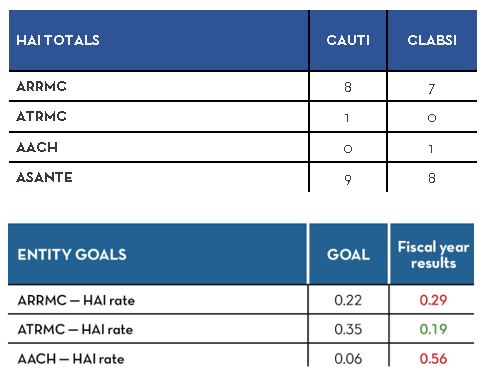Share:
With HAIs beginning to rise, it’s time to right the ship
It’s hard to imagine that our intense journey to prevent hospital-acquired infections started over six years ago. While we have made significant gains with our processes and our infection rates, navigating a pandemic, strained hospital capacity, campus construction projects and wildfires have stretched our capacity for improvement.
What has not changed is our commitment to our patients. Asante’s Vision is, “To be your trusted health partner for life — every person, every time.” The commitment we have to our patients to provide high-quality care and keep them safe is more important than ever.
You will note that as a system we did not meet our patient safety goals for FY 2020.

First and foremost, we want to keep our patients safe. Every hospital-acquired infection is an opportunity to improve how we deliver care to our patients. Preventing these infections means our patients leave the hospital with fewer complications and shorter, less expensive lengths of stay. We do not want to diminish the hard work we saw throughout our system. ATRMC, for example, reported its best year for patient safety with notable improvements in hospital-acquired infections. Yet we know we are not where we need to be, and that we are capable and competent to improve for our patients.
We will be increasing communications to help us all get back to the basics regarding HAIs. This begins with a refresh of bundle compliance and best-practice standards for CAUTI and CLABSI.
Catheter-associated urinary tract infections (CAUTI)
Care for patients with Foley catheters starts with the decision to use a Foley. Asante has specific indications for Foley catheter use as noted in our Care of an Indwelling Urinary (Foley) Catheter in Adult Patients![]() policy. Please review this to understand appropriate indications and remove Foleys when appropriate. Even providers have written “do not remove orders,” these Foleys still should be assessed daily and discussed with the provider for removal.
policy. Please review this to understand appropriate indications and remove Foleys when appropriate. Even providers have written “do not remove orders,” these Foleys still should be assessed daily and discussed with the provider for removal.
Bundled care of our Foley catheters is critical to ensure we are providing the best practice to patients every time. Assessing your patient’s Foley order and indication, and assuring their clinical picture still matches the need for a device, are key. When a device must remain in a patient, assess frequently that it is free of loops and kinks, that the bag remains below the bladder and that it is not on the floor. Finally, peri care is critical to preventing infections, with more frequent peri care for patients who are stooling.
Central line-associated bloodstream infections (CLABSI)
Care for patients with central lines also starts with the decision for a central line. The Central Venous Access Device (CVAD) Central Lines![]() policy has great details on types of lines and indications for use. Hemodialysis catheters are currently our highest-risk devices. Asante is continuing to work with DaVita to ensure streamlined processes and approach to hemodialysis line management.
policy has great details on types of lines and indications for use. Hemodialysis catheters are currently our highest-risk devices. Asante is continuing to work with DaVita to ensure streamlined processes and approach to hemodialysis line management.
Bundled care for central lines is critical to providing best practice to patients every time:
- Assess for appropriate indications and need for use.
- Ensure that dressings are clean, dry, intact and that the dressing has either a biopatch or is CHG-impregnated.
- Clearly mark the date on the dressing and tubing to inform other staff members when routine dressing changes are needed.
- Ensure tubing is capped to prevent infection into other entry points.
- Bathe patients with central lines daily in CHG.
Leaders and quality team members will continue to round to support bundle compliance. Together we can provide the highest level of quality and safety to our patients.
Resources:
If you have a question, please contact the author or relevant department directly.



